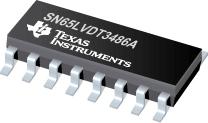Part Datasheet Search > TI > SN65LVDT3486A Datasheet PDF
SN65LVDT3486A Datasheet PDF - TI
| Manufacturer: | TI |
| Description: | HIGH-SPEED DIFFERENTIAL RECEIVERS |
| Documentation: | SN65LVDT3486A Datasheet (14 Pages) |
| Pictures: |
SN65LVDT3486A Datasheet PDF
ADatasheet has not yet included the datasheet for SN65LVDT3486A
If necessary, please send a supplementary document request to the administrator

SN65LVDT3486A Datasheet PDF (14 Pages)
SN65LVDT3486A Function Overview
This family of differential line receivers offers improved performance and features that implement the electrical characteristics of low-voltage differential signaling (LVDS). LVDS is defined in the TIA/EIA-644 standard. This improved performance represents the second generation of receiver products for this standard, providing a better overall solution for the cabled environment. The next generation family of products is an extension to TI\x92s overall product portfolio and is not necessarily a replacement for older LVDS receivers.
●Improved features include an input common-mode voltage range 2 V wider than the minimum required by the standard. This will allow longer cable lengths by tripling the allowable ground noise tolerance to 3 V between a driver and receiver.
●Precise control of the differential input voltage thresholds now allows for inclusion of 50 mV of input voltage hysteresis to improve noise rejection on slowly changing input signals. The input thresholds are still no more than ±50 mV over the full input common-mode voltage range.
●The high-speed switching of LVDS signals almost always necessitates the use of a line impedance matching resistor at the receiving-end of the cable or transmission media. The SN65LVDT series of receivers eliminates this external resistor by integrating it with the receiver. The nonterminated SN65LVDS series is also available for multidrop or other termination circuits.
●The receivers also include a (patent pending) fail-safe circuit that will provide a high-level output within 600 ns after loss of the input signal. The most common causes of signal loss are disconnected cables, shorted lines, or powered-down transmitters. This prevents noise from being received as valid data under these fault conditions. This feature may also be used for wired-OR bus signaling.
●The intended application of these devices and signaling technique is for point-to-point baseband data transmission over controlled impedance media of approximately 100 . The transmission media may be printed-circuit board traces, backplanes, or cables. The ultimate rate and distance of data transfer is dependent upon the attenuation characteristics of the media and the noise coupling to the environment.
●The SN65LVDS32A, SN65LVDT32A, SN65LVDS3486A, SN65LVDT3486A, SN65LVDS9637A, and SN65LVDT9637A are characterized for operation from -40°C to 85°C.
● Meets or Exceeds the Requirements of ANSI EIA/TIA-644 Standard for Signaling Rates up to 400 Mbps
● Operates With a Single 3.3-V Supply
● \x962-V to 4.4-V Common-Mode Input Voltage Range
● Differential Input Thresholds < 50 mV With 50 mV of Hysteresis Over Entire Common-Mode Input Voltage Range
● Integrated 110- Line Termination Resistors Offered With the LVDT Series
● Propagation Delay Times 4 ns (typ)
● Active Fail Safe Assures a High-Level Output With No Input
● Recommended Maximum Parallel Rate of 100 M-Transfers/s
● Outputs High-Impedance With VCC < 1.5 V
● Available in Small-Outline Package With 1,27 mm Terminal Pitch
● Pin-Compatible With the AM26LS32, MC3486, or uA9637
●Signaling rate, 1/t, where t is the minimum unit interval and is expressed in the units bits/s (bits per second)
show more
SN65LVDT3486A Documents
SN65LVDT3486 Documents
TI
Quad LVDS Receiver with -2 to 4.4V Common-mode Range 16-SOIC -40℃ to 85℃
TI
Quad LVDS Receiver with -2 to 4.4V Common-mode Range 16-SOIC -40℃ to 85℃
TI
Quad LVDS Receiver with -2 to 4.4V Common-mode Range 16-SOIC -40℃ to 85℃
Part Datasheet PDF Search
Example: STM32F103
72,405,303 Parts Datasheet PDF, Update more than 5,000 PDF files ervery day.

